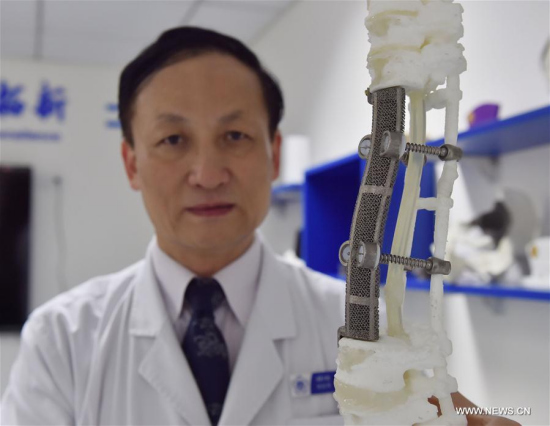
Liu Zhongjun, a surgeon of Peking University Third Hospital, displays a 19-centimeter 3D-printed spinal replica in Beijing, capital of China, July 19, 2016. (Xinhua/Li Wen)
Chinese doctors set a new record in a spinal operation to replace five vertebrae with 3D-printed replicas.
The 3D-printed vertebrae measured 19 centimeters, the longest ever in a successful operation.
A 41-year-old cancer patient, surname Yuan, underwent the surgery at Peking University Third Hospital on June 12, and has been able to walk by himself since the operation, his doctors said.
During the six-hour procedure, the replica, made from titanium powder, was inserted into his spine to fill the void left after five tumor-affected vertebrae were removed.
Without the pioneering operation, he would likely have been paralyzed, according to the doctors.
In a previous operation on May 6, the tumor was removed, along with the posterior sections of the five vertebrae. The gap was filled with titanium rods and screws -- a traditional treatment that ideally allows for patient mobility.
The 3D-printed bone was used to support the spine after removal of the remaining anterior sections in the June operation. The standard solution of inserting a titanium tube into the missing section would have had major disadvantages.
The hollow titanium tube is straight and does not match human anatomical structure. The tube could also detach over time since the missing section of vertebrae is large, which would lead to paralysis, according to Liu Zhongjun, chief surgeon.
"The 3D printing technology offers a better option. It enables us to produce a replica resembling Yuan's original bone structures, both in shape and length, and it is firm," Liu said.
The implant also has tiny pores that allow neighboring bone cells in normal vertebrae to grow. This will help with fusion of the replica and real bones, he said.
Yuan was diagnosed with chordoma, a rare cancer that can occur anywhere in the spine and skull, in December after suffering acute lower back pain. In January, he turned to the Peking University Third Hospital, which has a research team that has studied 3D-printing for orthopedics since 2009.
"I believe in the new technology. I've prepared myself for risks. My disease can't be treated in the conventional way and it makes no sense for me to wait," said Yuan, who works in the catering industry in Beijing and has a five-year-old daughter.
Yuan said he was able to walk with crutches two weeks after the surgery. A portion of his medical costs was exempted because of the experimental nature of the treatment, he said.
The team developed the only two 3D-printed body implant products registered by the China Food and Drug Administration, which include a hip joint product and the vertebrae product approved in September 2015 and May respectively.


















































